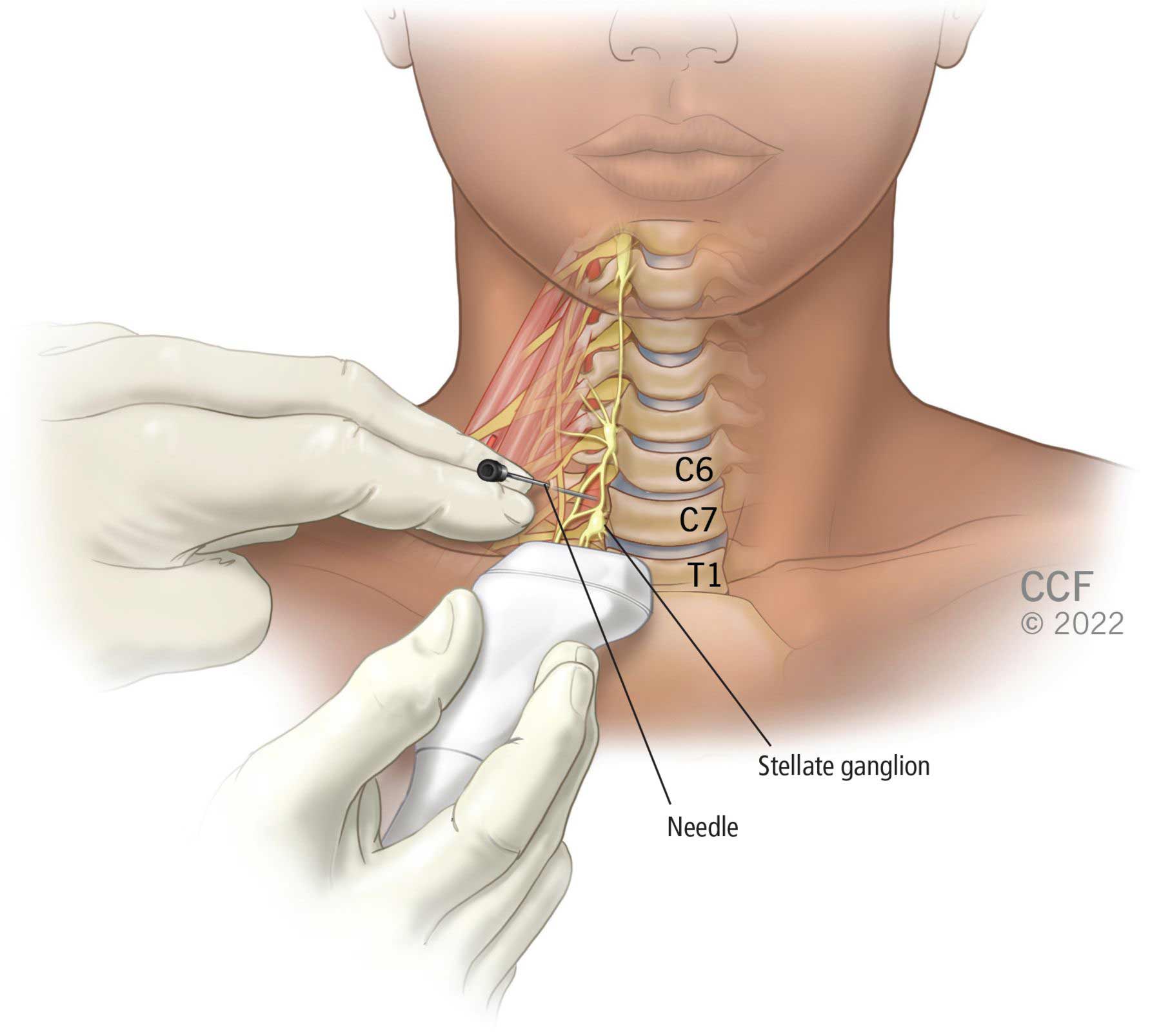A stellate ganglion block is an injection of medication into a collection of nerves at the bottom of the front side of your neck. It can help treat a variety of circulation and pain conditions, such as complex regional pain syndrome and peripheral artery disease. Researchers are studying how it may help mental health conditions like PTSD.
Advertisement
Cleveland Clinic is a non-profit academic medical center. Advertising on our site helps support our mission. We do not endorse non-Cleveland Clinic products or services. Policy

A stellate ganglion block (SGB) is an injection of anesthetic medication into a collection of nerves called the stellate ganglion. These nerves are located in your neck, on both sides of your voice box. The injection can help relieve pain in your head, neck, upper arm and upper chest. It also can help increase circulation and blood flow to your arm.
Advertisement
Cleveland Clinic is a non-profit academic medical center. Advertising on our site helps support our mission. We do not endorse non-Cleveland Clinic products or services. Policy
The stellate ganglion is a bundle of sympathetic nerves located in the front of your neck near your first ribs (these ribs are right underneath your collarbones). You have one on each side of your neck. A ganglion is a collection of nerves. The stellate ganglion is shaped like an oval but may also look like a star (“stellate” means “star”).
The stellate ganglion provides most of the sympathetic nerve signals to your head, neck, arms and a portion of your upper chest. Your sympathetic nervous system is part of your autonomic nervous system. It’s responsible for many functions your body controls without you thinking about them. This can include control of your heart rate, blood pressure, sweating and other functions.
To have a stellate ganglion, two ganglia (more than one ganglion) have to fuse together. The two that need to fuse are the inferior cervical ganglion and first thoracic ganglion. Inferior here means “underneath.” The inferior cervical ganglion passes underneath the last vertebra of the cervical (neck) section of your spine. The first thoracic ganglion exits your spine at the same level as the first thoracic vertebra. That’s the topmost vertebra in the thoracic (upper back) section of your spine.
Advertisement
Only 80% of people worldwide have a stellate ganglion. In everyone else, these ganglia don’t fuse in the usual manner.
Healthcare providers use stellate ganglion blocks to diagnose sympathetically mediated pain (SMP). This is a chronic neuropathic pain condition that happens when your sympathetic nervous system sends pain signals to your brain for unknown reasons.
Providers also use the injections to treat circulation problems, pain symptoms and conditions or nerve injuries, including:
Researchers have been studying the use of stellate ganglion blocks (SGBs) for the treatment of post-traumatic stress disorder (PTSD) since 1990. The research has yielded mixed evidence — some people experience an improvement in their PTSD symptoms, while others have no changes.
Researchers think the reason SGBs may help PTSD is due to a decrease in nerve growth factor levels. This reduces norepinephrine levels and increased sympathetic nervous system activity that happens with PTSD.
U.S. Food and Drug Administration hasn’t approved SGBs for the treatment of PTSD. But some healthcare providers may use them “off-label” for PTSD — typically only if other treatments aren’t working.
More recently, researchers have been studying the use of SGBs for other mental health conditions, including depression, anxiety and psychosis.
In general, you can expect the following during a stellate ganglion block injection:
Usually, the procedure takes less than 30 minutes.
After the procedure, you’ll stay in a recovery room where a healthcare professional will carefully monitor you for any complications — usually for about 40 to 60 minutes. Your provider will give you instructions for care at home. You’ll need someone else to drive you home.
Advertisement
Some people report pain relief immediately after the injection, but the pain may return a few hours later as the local anesthetic wears off. Other people have longer-term relief that helps them to reduce their medication use and increase their participation in physical therapy.
How long the pain relief lasts is different for each person. Some may be pain-free for days or weeks. Usually, people need a series of injections to continue the pain relief. Sometimes, it takes only two injections; sometimes, it takes more than 10. The relief tends to last longer with each treatment.
Side effects of the procedure may include:
These effects usually go away within a few hours.
Serious complications are rare but can include:
Advertisement
Contact your healthcare provider immediately if you experience any new symptoms or complications from the stellate ganglion block, such as an infection or prolonged difficulty with swallowing.
Stellate ganglion blocks can help treat a variety of pain and circulation conditions. But the results can vary considerably from person to person. If you’re feeling anxious about receiving a stellate ganglion block injection, don’t hesitate to ask your healthcare provider about it and the procedure. They can answer any questions you may have.
Advertisement
Comprehensive pain recovery treatment plans can help you manage your pain levels and symptoms more easily.

Last reviewed on 02/21/2023.
Learn more about the Health Library and our editorial process.